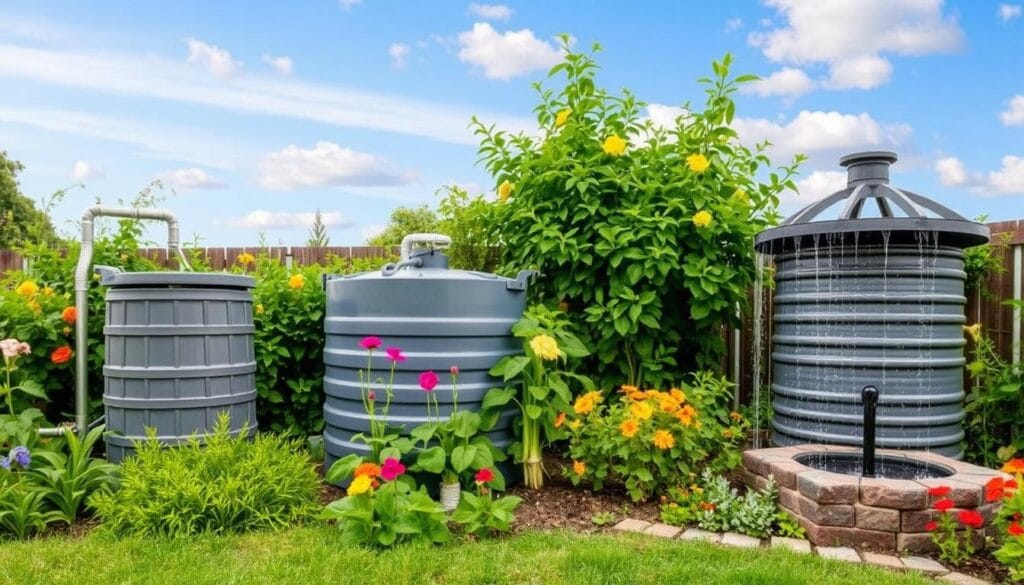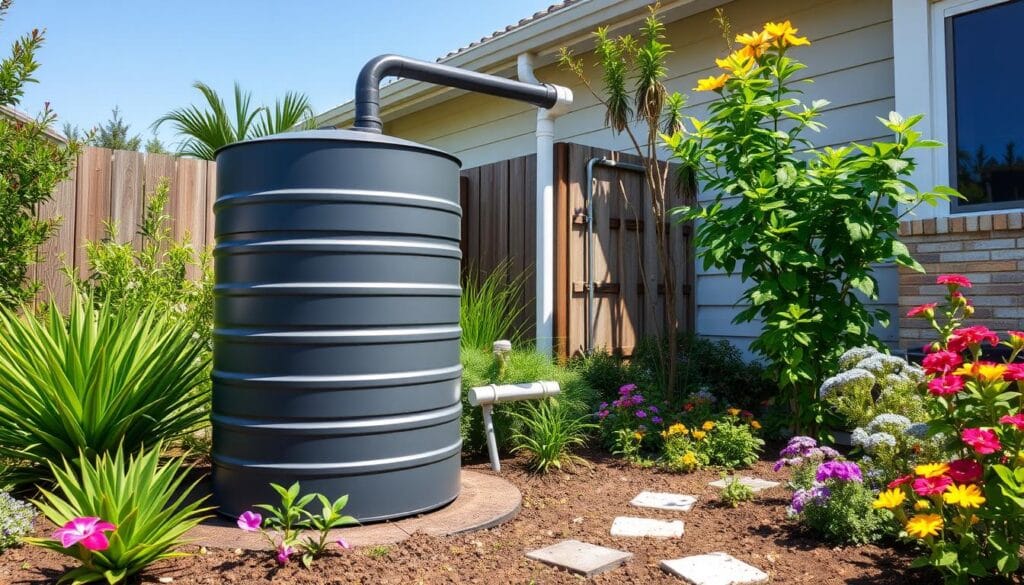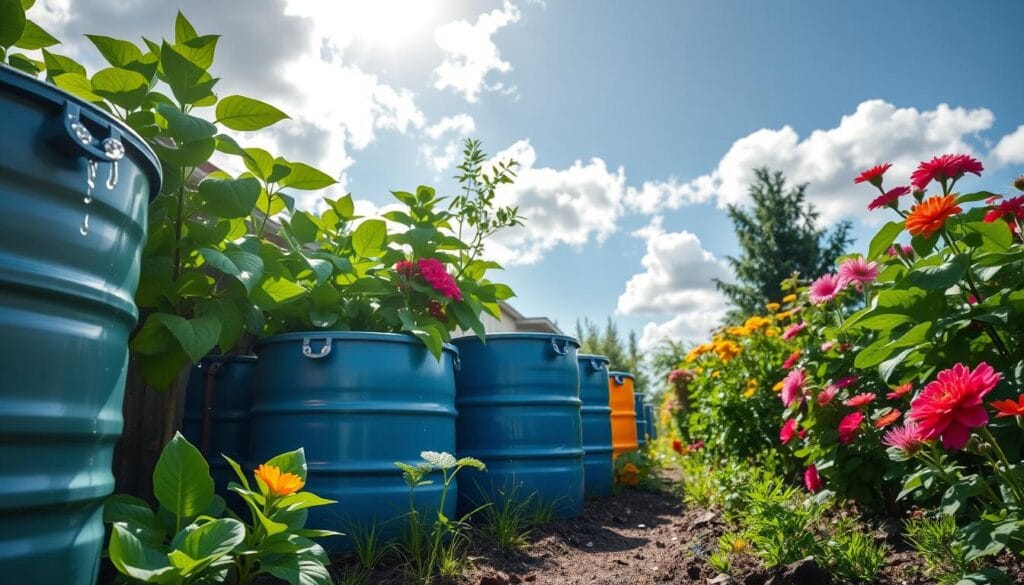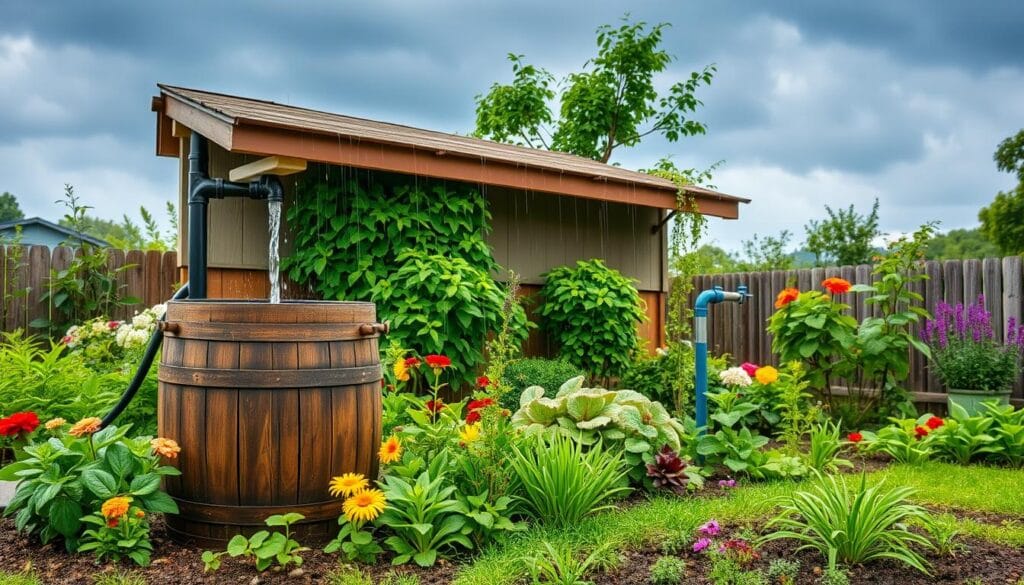Thinking about making your garden more sustainable? Rainwater harvesting for gardening is a great option. It involves collecting and storing rainwater for later use. This method is key in places like California, where summers are dry and water is scarce.
By using rainwater, you cut down on treated water use. This helps the environment a lot.
In the western U.S., 72% of the area is facing severe drought. Collecting rainwater gives your plants a natural, balanced water source. This helps them grow well and lessens the need for city water.
Rainwater harvesting is good for your wallet and your plants. It’s a smart choice for those who care about the planet.
Key Takeaways
- Rainwater harvesting for gardening is a sustainable way to collect and store rainwater for future use.
- Eco-friendly garden irrigation methods like rainwater harvesting can reduce reliance on municipal water supplies.
- Water conservation techniques, including rainwater harvesting, are essential in areas prone to drought.
- Rainwater harvesting can lead to cost savings by reducing water bills and promoting sustainable gardening practices.
- Implementing rainwater harvesting systems can contribute to community sustainability and environmental awareness.
- Rainwater harvesting enables watering flexibility, allowing users to control how and when to use collected rainwater.
- Rainwater is beneficial for plant growth due to its natural purity, balanced pH, softness, and temperature harmony.
What is Rainwater Harvesting?
Rainwater collection is a simple way to save water and cut down on using city water. It’s a key part of sustainable gardening. This method helps the environment and saves money on water bills.
When you think about getting a rainwater harvesting system, know the main parts. These are gutters, downspouts, and tanks. It’s a smart move for a greener garden.
- Reduced water bills
- Improved plant health and growth
- Minimized environmental impact
- Increased self-sufficiency
Embracing rainwater harvesting and green gardening has many perks. It’s good for the planet and your wallet. Simple changes can make a big difference.
| Benefits of Rainwater Harvesting | Description |
|---|---|
| Cost Savings | Reduced water bills and lower costs for gardening |
| Environmental Benefits | Minimized demand on municipal water supplies and reduced stormwater runoff |
| Improved Plant Health | Healthier plants and improved growth due to the use of natural, chemical-free water |
Benefits of Rainwater Harvesting for Gardens
Harvesting rainwater for your garden can cut down on water bills. It also supports sustainable gardening. Using rainwater in your garden reduces your need for municipal water, which is great during droughts or water shortages.
This method helps ease the pressure on traditional water sources. It also gives your plants a natural, chemical-free water source.
Rainwater is full of nutrients and has a slightly acidic pH. This makes it perfect for plants that do well in acidic conditions. Some main advantages of using rainwater in your garden are:
- Lower water bills: Collecting and using rainwater can greatly reduce your water bills. It also cuts down on your need for municipal water.
- Healthier plants: Rainwater lacks harmful chemicals like chlorine and fluoride. It also has dissolved nitrogen, which is key for plant growth.
- Good for the environment: Harvesting rainwater helps reduce stormwater runoff. It also eases the burden on groundwater and surface water reservoirs. Plus, it supports eco-friendly gardening.
Adding rainwater harvesting to your garden care can make your gardening more sustainable and eco-friendly. This not only helps your plants but also aids in fighting water scarcity. It shows your commitment to environmental stewardship.
How to Set Up a Rainwater Harvesting System
To start collecting rainwater for your garden, you need to set up a rainwater harvesting system. First, choose the right location for your system. Then, gather the necessary materials and supplies. This way, you can use rainwater for your garden, reducing your need for traditional water sources.
When picking a location, think about where you’ll use the rainwater. It could be near your garden or a spot in your yard that needs water often. Place your system close to where you’ll use the water. This makes it easier to use and helps prevent contamination.
Required Materials and Supplies
You’ll need a storage tank, a roof catchment area, gutters, and downspouts for a basic system. You might also want a first flush diverter and a filter to keep the water clean. For bigger needs, consider dry or wet systems, which hold more water and support your eco-friendly goals.
Popular storage options include decorative barrels, food-grade drums, and IBC totes. For more water, you can get tanks from 500 gallons to several thousand. A rainwater harvesting system can lower your water bills and help your garden be more self-sufficient.
| Storage Option | Capacity | Price Range |
|---|---|---|
| Decorative Barrel | 50-100 gallons | $20-$50 |
| Food-Grade Drum | 55 gallons | $20-$30 |
| IBC Tote | 275-330 gallons | $100-$300 |
| Large Tank | 500-10,000 gallons | $500-$5,000 |
Types of Rainwater Harvesting Systems
Collecting rainwater for your garden is essential. You’ll need a durable container like a barrel, tote, or tank. This practice helps reduce stormwater runoff and pollution. It also saves you money on water bills.
There are many types of rainwater harvesting systems. Each has its benefits and drawbacks. Here are a few common ones:
- Above-ground tanks: These are popular for their ease of installation and maintenance. They come in various sizes and materials like plastic, metal, and concrete.
- Below-ground cisterns: Ideal for storing large amounts of water, these tanks are installed underground. They need regular cleaning to stay free from contaminants.
- Rain barrels and drip systems: These are affordable and simple to set up. They’re great for small gardens and can water plants directly or feed a drip irrigation system.
Choosing the right rainwater harvesting system can save you money and improve your garden’s health. It’s a step towards a more sustainable and eco-friendly garden.

| System Type | Advantages | Disadvantages |
|---|---|---|
| Above-ground tanks | Easy to install and maintain, versatile | Can be visually unappealing, may require additional support |
| Below-ground cisterns | Can store large amounts of water, out of sight | Requires regular cleaning and maintenance, higher upfront cost |
| Rain barrels and drip systems | Cost-effective, easy to set up, perfect for small gardens | Limited storage capacity, may require additional components |
How to Integrate Rainwater in Your Garden
Exploring rainwater collection benefits is key. It’s important to know how to use it in your garden. This can help you use less municipal water and make your garden more eco-friendly. Rainwater is great for plants because it’s chemical-free, helping them grow well.
There are many ways to use rainwater in your garden. You can link it to your irrigation system for automatic watering. Or, you can water plants directly or use it for composting. Using rainwater can lower your water bills and help the environment.
- Reduced water bills
- Improved plant health and growth
- Minimized environmental impact
- Increased water conservation
Using rainwater for irrigation makes your garden more sustainable. As you learn more about rainwater harvesting, keep focusing on eco-friendly gardening. This will help your garden stay healthy and strong.
| Benefits of Rainwater Collection | Description |
|---|---|
| Cost Savings | Reduced water bills through the use of collected rainwater |
| Environmental Benefits | Minimized environmental impact through reduced stormwater runoff and decreased demand on municipal water supplies |
| Improved Plant Health | Healthier plant growth through the use of chemical-free rainwater |
Maintenance Tips for Your Rainwater System
When you start harvesting rain for plants and using garden water management methods, keeping your system in check is key. This ensures it works well and gives you a steady water supply for using harvested rainwater in gardening. Regular upkeep also stops contamination and makes your system last longer.
To keep your system running smoothly, start by putting downspout filters in place. These catch debris and keep the water clean. If you have room, adding a rain garden can help capture runoff and filter it back into the earth. Here are some important maintenance tasks to do:
- Regularly inspect and clean your gutters, filters, and tanks to prevent contamination.
- Check your system for any signs of damage or wear and tear, and make repairs as needed.
- Consider implementing winterization techniques to protect your system from freezing temperatures and damage.
By sticking to these maintenance tips, your rainwater system will keep giving you water for your garden. Always focus on garden water management and using harvested rainwater in gardening to maximize your system’s benefits.

| Maintenance Task | Frequency |
|---|---|
| Inspect and clean gutters, filters, and tanks | Regularly |
| Check system for damage or wear and tear | Regularly |
| Implement winterization techniques | As needed |
Understanding Local Regulations
When you start rainwater collection, knowing local laws is key. Sustainable gardening practices are great, but some places have rules for eco-friendly garden irrigation. Always check with your local government before installing a rainwater system.
Some places have strict rules, while others don’t. Knowing your area’s rules is important to avoid problems. Here are some things to keep in mind:
- Check water quality guidelines to ensure the collected rainwater meets the required standards.
- Obtain necessary permits and follow the permitting requirements for rainwater harvesting systems in your area.
- Understand the restrictions on how harvested rainwater can be used, such as for eco-friendly garden irrigation or other non-potable purposes.
By following local rules, you can have a successful rainwater collection system. It will help your sustainable gardening practices and make your garden more eco-friendly.
| State | Regulations | Incentives |
|---|---|---|
| California | Allows rainwater harvesting with certain stipulations | Offers rebates for rainwater harvesting systems |
| Colorado | Encourages rainwater harvesting with incentives | Provides tax credits for rainwater harvesting systems |
| Illinois | Allows rainwater harvesting with specific guidelines | Offers grants for rainwater harvesting projects |
Potential Challenges in Rainwater Harvesting
Thinking about using rainwater for your garden? It’s good to know about possible hurdles. The cost to set it up can be high. But, you’ll save money on water bills and keep your plants healthy over time. This makes rainwater harvesting a smart choice for your garden.
Space and seasonal changes can also be issues. Here are some tips to help:
- Figure out how much water you need and where to put your tank
- Pick the right tank size and place it well
- Keep your system in good shape to work well and safely

Knowing these challenges and how to tackle them will help you use rainwater effectively.
It’s also important to know the local rules about using rainwater. This keeps your garden safe and follows the law. Rainwater harvesting is a smart move for your garden, saving money and helping the environment.
| Challenge | Solution |
|---|---|
| Initial setup cost | Regularly maintain the system and choose right tank size |
| Space limitations | Assess water needs and identify suitable catchment and storage spaces |
| Seasonal variability | Regularly maintain the system and choose the right tank size |
Plants That Benefit from Rainwater
Using sustainable gardening practices like rainwater collection is great for plants. It gives them warm, chlorine-free water for healthy growth. Plants like California poppies and manzanitas do well with little water and help local wildlife.
These plants are perfect for rainwater collection systems. They can handle short water periods and drought. Rainwater harvesting saves water and gives plants the moisture they need.
- Drought-resistant plants like succulents and cacti
- Vegetables like tomatoes and cucumbers
- Herbs like basil and rosemary
By using sustainable gardening practices and eco-friendly garden irrigation, you can have a water-efficient garden. Choose plants that fit your climate and soil. Try different rainwater collection systems to see what works best.
With the right plants and rainwater collection systems, you can have a beautiful, sustainable garden. It’s good for you and the environment. So, start harvesting rainwater for your garden today!
Community Involvement and Education
Exploring rainwater harvesting for gardening shows the importance of community and education. Sharing knowledge helps inspire others to use eco-friendly methods. This collective effort can greatly benefit the environment.
Local workshops and resources are key in teaching communities about rainwater harvesting. They offer hands-on training and demonstrations. By attending these, you can learn and share your knowledge, helping create a sustainable future.
Sharing Best Practices
Sharing success stories is a great way to encourage community involvement. Use social media, local newspapers, or events to spread the word. Highlighting achievements can motivate others to adopt rainwater harvesting.
Some great examples include:
- Green School in Bali, which uses rainwater harvesting in its eco-friendly setup
- A school in Delhi, where a rainwater system saves about 50,000 liters of water each year
- Brightworks School in San Francisco, where a rainwater system helps students learn STEM skills

By focusing on community involvement and education, we can build a sustainable future. Remember to share your knowledge and inspire others to use rainwater in gardening and more.
| Community Initiative | Location | Impact |
|---|---|---|
| Green School | Bali | Eco-friendly infrastructure |
| School Rainwater Harvesting System | Delhi | 50,000 liters of water saved annually |
| Brightworks School | San Francisco | Enhanced STEM skills for students |
Future Trends in Rainwater Harvesting
When thinking about rainwater collection systems, it’s key to look at future trends. Sustainable gardening and eco-friendly irrigation are on the rise. Smart technology is leading to new ways to manage water and cut down on waste.
In 2024, we’ll see more soaker hose systems, soil moisture sensors, and smart gardening apps. These tools will help gardeners save water and make irrigation more efficient. Also, drought-resistant plants and graywater recycling will become more popular, offering green alternatives for gardeners.
These trends offer many benefits, including:
- Less water use
- More efficient irrigation
- Healthier plants
- More eco-friendly gardens
By adopting these trends, you can make your garden more sustainable and eco-friendly. This will also help lower your water bills and environmental impact. As you explore these new solutions, think about your garden’s needs and climate. Choose what works best for your gardening goals.
| Trend | Benefits |
|---|---|
| Soaker hose systems | Efficient watering, reduced evaporation |
| Soil moisture sensors | Optimized watering schedules, reduced waste |
| Smart gardening apps | Personalized recommendations, improved plant health |
Conclusion: Embrace Eco-Friendly Gardening
Discovering rainwater harvesting and eco-friendly gardening can change your garden and wallet. It also helps the environment. By using harvested rainwater for your plants, you save money and support a green water system.
Many gardeners, 72%, are already using sustainable methods like composting and organic fertilizers. 68% are also focusing on making gardens more resilient to climate change. This shows eco-friendly gardening is the future.
Start your rainwater harvesting project today for a greener garden. You’ll save water and money, and help the planet. Your garden, wallet and Earth will thank you for going green.
FAQ
What is rainwater harvesting and why is it important for gardening?
Rainwater harvesting collects and stores rainwater for gardening. It’s key because it saves municipal water, cuts down on environmental harm, and helps plants grow well.
What are the key components of a rainwater harvesting system?
A rainwater harvesting system has gutters, downspouts, and tanks to hold the water.
How can rainwater harvesting benefit my garden?
It can lower your water bills, make plants healthier, and reduce environmental impact. You can use the rainwater to water plants or in your irrigation system.
What steps are involved in setting up a rainwater harvesting system?
First, pick the right spot. Then, get the materials and install the gutters, downspouts, and tanks.
What are the different types of rainwater harvesting systems available?
You can choose from above-ground tanks, below-ground cisterns, or rain barrels with drip systems. The best one depends on your needs, space, and budget.
How can I integrate rainwater into my garden’s irrigation system?
Connect the tank or cistern to your irrigation system. This way, you can use the rainwater to water plants directly or through an automated system.
What maintenance is required for a rainwater harvesting system?
Regular cleaning and checks are needed. Also, protect the system from cold weather.
Do I need to consider any local regulations or guidelines for rainwater harvesting?
Yes, follow local rules on rainwater harvesting. This includes water quality and permits.
What are some potential challenges in setting up a rainwater harvesting system?
Challenges include the cost, space, and how much rain you get.
What types of plants benefit the most from rainwater harvesting?
Drought-resistant plants, vegetables, and herbs do well with rainwater. It’s a natural and sustainable water source for them.
How can I get my community involved in rainwater harvesting?
Join local workshops, share tips, and use resources that support sustainable gardening and rainwater harvesting.
What are the future trends in rainwater harvesting for gardening?
Expect new tech, like better storage and systems, and more focus on saving water and caring for the environment.
Source Links
- Rainwater Harvesting: How to Collect Rainwater
- Sustainable Gardening: A guide to harvesting rain – Terra Firma Landscapes London
- Creating a Zen Garden Design in 5 Easy Steps
- The Benefits of Rainwater Harvesting: Sustainable Water Management for Market Gardeners
- How rainwater harvesting can help households, gardeners live more sustainably
- Benefits Of Rainwater Harvesting For Sustainable Gardening | Alitex
- Nurture Your Garden with Rainwater Harvesting: Benefits and Setup Guide | Rain Harvesting
- How to Set Up a Rainwater Harvesting System: A Simple Guide – Tips and How To
- Building Your Own Rainwater Collection System – Bootstrap Farmer
- Rainwater Harvesting 101
- Learn How to Collect and Use Rainwater
- Rainwater Harvesting 101
- Beginner’s Guide to Rainwater Harvesting
- Beginner’s Guide to Rainwater Harvesting
- A Beginner’s Guide to Rainwater Harvesting
- Rainwater Harvesting 101
- Beginner’s Guide to Rainwater Harvesting
- States Where It Is Illegal To Collect Rainwater – Today’s Homeowner
- Rainwater Harvesting 101
- Unlock the Potential of Rain: A Beginner’s Guide to Rainwater Harvesting – The Green Innovators Journal
- Rainwater Harvesting for Use in the Garden
- Soak up the rain with a rain garden
- Plants for Passive Rainwater Harvesting Gardens
- Community Involvement in Environmental Protection as a Key to Successful Environmental Projects – One More Tree Foundation
- How to Build a Rainwater Harvesting System in Schools
- Rainwater Harvesting 101
- 2024 Top Watering Trends for Green Living
- Rain gardens and bathwater reuse becoming trends, RHS says
- Innovative Rainwater Harvesting: Smart Technologies and Sustainable Solutions for Urban Resilience
- Gardening Trends 2024: Embracing Diversity, Sustainability, and Creativity — Palos Verdes Pulse
- Eco-Friendly Gardening: 7 Easy Ways to Cultivate a Sustainable Oasis – Bluestem Gardening






Pingback: Chemical-Free Lawn: 5 Powerful Secrets for Lush Green Grass